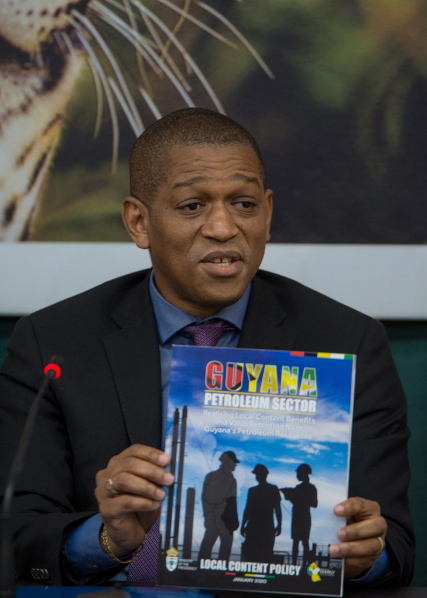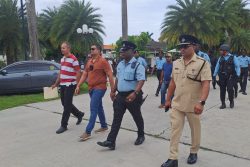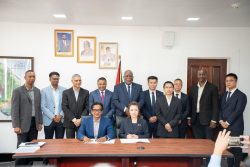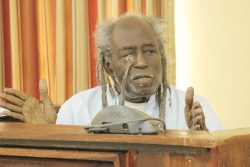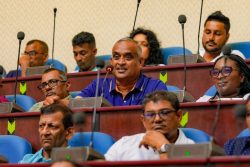The third draw of crude oil in the Stabroek Block will be lifted early next week after government and ExxonMobil have settled on a value for the oil being extracted from the Liza field and this will go to Guyana.
This is according to Director of the Department of Energy (DoE), Mark Bynoe, who told a press conference yesterday, that the approximately one million barrels being lifted represent part of Guyana’s profit oil allocation of 12.5%.
He reminded that the country will also receive 2% royalty on gross production from the block and explained that all revenue earned from both of these will be deposited in the Natural Resources Fund (NRF) which is currently being managed by the Bank of Guyana. The oversight mechanisms for the NRF have not yet been established.
At a press conference on November 6 last year, Bynoe had been reported as saying that the first three lifts of oil were for ExxonMobil.
In December the DoE announced that Shell Western Supply and Trading Limited would be buying the first three cargoes of Guyana’s oil.
The department did not indicate the price at which this purchase would be executed and Bynoe when asked yesterday said that he could not discuss price at the press conference.
He stressed that the department would be working with the Extrac-tive Industries Transparency Initiative (EITI) which has specific guidelines for reporting on first trades of oil.
He however indicated that the DoE and its sister agencies are continuing to work with the operator ExxonMobil’s subsidiary Esso Exploration and Production Guyana Limited (EEPGL) to complete Article 13 of the Production Sharing Agreement (PSA) before Guyana lifts its first barrel of crude oil.
The article referenced specifically deals with the valuation of the crude and Bynoe noted that reaching consensus on this value is necessary as it has implications for entitlement scheduling etc.
A multi-agency team with members from the DoE, Guyana Revenue Authority, Guyana Geo-logy and Mines and the Environmental Protection Agency are working along with the consultant IHS Markit to examine the cost recovery claims of the contractor.
He further explained that the second phase of the crude marketing process will be launched “sometime this month”
DoE had previously explained that there would be a two-step crude marketing process with the first phase being a direct sale process in December, 2019.
The second an open market Request for Proposals (RFP) was to be launched in early 2020 for a marketing agent to market Guyana’s crude entitlements from the Liza 1 field on a term basis.
It has been explained that this two-step process, which was heavily criticized, was necessary to allow, amongst other things, for adequate preparation in structuring and completing the RFP for marketing in early 2020.
This RFP is still not complete as Bynoe noted that the second step will be launched “when they get the RFP”.
He explained that the DoE will be working with the National Procurement and Tender Administration Board (NPTAB) to facilitate a prequalification process through expression of interest. Applicants with the technical expertise and experience will move forward to bid.
This is one of several actions being taken by the department to increase it access to the skills necessary to improve its ability to administer the Oil and Gas Sector.
Hot off the press
Another action is the completion of the Local Content Policy, which still needs to be transformed into law. The government has been severely criticised for its sloth in finalising the policy.
Noting that the document was “hot off the press”, Bynoe explained that “it remains…a fit for purpose policy as it offers a balanced alignment between the government of Guyana’s policy goals whilst maintaining consistency with Guyana’s international and regional trade and economic cooperation obligations.
He stated that it promotes education, inclusion and advancement of Guyanese persons who demonstrate expertise and experience required to participate in the petroleum industry.
“It ensures participation of Guyanese persons in employment opportunities, it assures capable Guyanese suppliers of contracting and procurement opportunities within the petroleum sector inside and outside of Guyana. It stimulates efficiency and cost benefits for the oil and gas sector and enhances alignment with good industry standards in the petroleum sectors [and] promotes world class capacity enhancement and high quality governance in key state institutions,” he said adding that the document would be shared with government officials before being made public later this week,
According to the director his department has been working with the operators to commence reporting on local content performance as per the matrices in this new local content policy.
These operators are being asked not just to provide annualized plans but a more programmatic approach so that one is able to see precisely where on an annualized basis the sector is headed.
“Also one of the things we have stressed very strongly is for them to provide us with an annual procurement plan so Guyanese suppliers will know precisely what is expected and when it is expected so that they can better position themselves to access these opportunities as they present themselves,” Bynoe explained.
He told reporters that the last report on the matter stated that as of December 2019, 1,900 Guyanese are directly employed within the petroleum sector with 75% being in skilled and professional categories while 100% of basic skills were being supplied by Guyanese who are mainly from Regions Four, Three and Six.
Additionally 750 Guyanese vendors have been engaged and the company spent over $120 million in the fourth quarter of 2019.
As a demonstration of its own commitment to local content, Bynoe explained that the department has contracted international firm Hunton Andrews Kurt LLP in association with local law firm Cameron and Shepherd to revise, replace and develop the Act and legislation to govern the petroleum sector.
This contract is expected to last for one year during which the firm will also provide legal advice and build local expertise.
According to the director, the work done during this consultancy is “critical to setting out provision to level the proverbial playing field, bring better clarity to the sector’s operations and enhance operational efficiencies.”
The entire consultancy will cost US$1.2 million and is being financed via a US$20 million World Bank Loan.
Bynoe was keen to note that the consultancy is not just to revise the petroleum exploration and production act but all aspects of the petroleum industry.
“We have been clamouring for legislation around local content. We have no such legislation. All of those have to be developed. There’s been clamouring in some sector for a modular refinery. We have nothing that governs downstream activities. We have nothing that governs midstream activities. Then we go to our sister agencies such as the EPA…what regulation would they have that will govern the petroleum sector? There is a dearth of such regulations they are expected to look at the wide sweep of regulations within the sector. Additionally the contract amount also includes legal advice to department on all matters oil and gas,” he explained, adding that one it is completed Guyana “will have a robust framework in terms of building the sector”.
